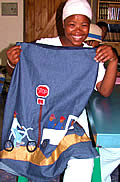All these quilts by the Pomegranate Quilters of the Bethesda Arts Centre were on display at the Hout Bay Exhibition, Cape Town in 2009.
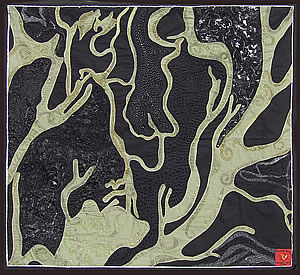 Our Roots 1 Our Roots 1
This quilt is about our San roots. The black represents the darkness of space, before the creation of the sun and stars. Our roots go back into the far distant past, before the wise woman made the children throw the sun up into the sky. Our roots are the green life force, that carries our people from a time before time, into the present. Larger picture
|
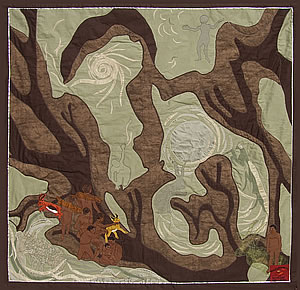 Our Roots 2 Our Roots 2
Our roots 2 is grounded in the earth, with the veins of life travelling through like sap. In one corner is the first family of people, in harmony with the animals they hunt and eat, as well as respect. On their backs they carry firewood. In the far right hand corner is//Kabbo, the shaman who passed on many of these stories to be collected and kept in book form for future generations.
Behind them, representing a different plane of existence, are the beings who make up the ethereal universe, the Rainbull, the Girl who makes stars, the sun in its early stage of creation, the moon with the hare, representing the origin of death, and the Mantis, the ever-present being who represents the Trickster God, or the elusive nature of life itself. Larger picture |
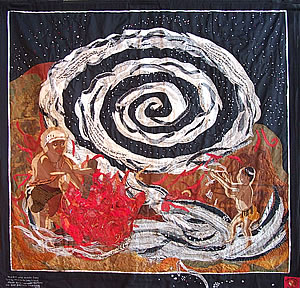 The Girl Who Made Stars The Girl Who Made Stars
In this story, a young woman throws wood ash into the sky, where it forms into the milky way. On the left hand side of the quilt, her mother tends the fire, from which the stars will be made. The great spiral of the milky way, dominates the sky. On it are embroidered words from the story as //Kabbo told it. (Sold) Larger picture |
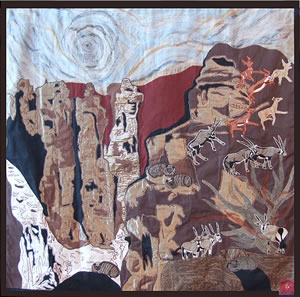 The Valley of Desolation The Valley of Desolation
The Valley of Desolation is a spot of great natural beauty near Nieu Bethesda where we live. On it gemsbok, springbok, a klipbokke, and some dassies spring around on the rocks. It makes us hungry to look at them. The best to eat is the dassie. If we are lucky, we will also find some dassie piss, which is excellent medicine for kidneys.
Larger picture |
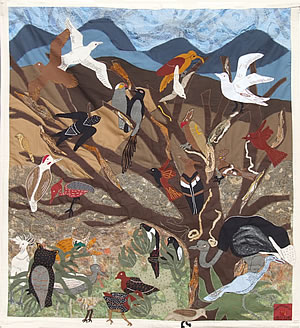 The Birds of the Karoo The Birds of the Karoo
We love birds because they come in the summer and sing. We love ostriches because we eat their wings and their meat and their eggs, and because the First People also ate eggs. The eggshell also makes medicine which we use for our children for wind, and also for ourselves. Ostriches taste lekker, like fish. We love the colour of the birds, the hoopoe, the sparrows, but not owls, because they bring bad news, and death. We enjoyed making the plants.
Larger picture |
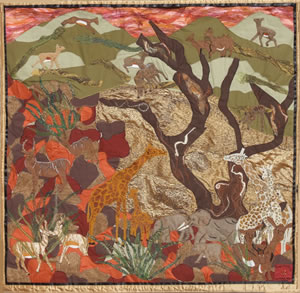 The Drinking Pool The Drinking Pool
The Karoo is a dry place, but there is water in our village of Nieu Bethesda. In this quilt, all the animals are gathering to drink. We haven’t got elephants and giraffes in Nieu Bethesda, but we have seen them in pictures. We have a lot of springboks and kudus. The two springboks are getting together, talking to each other. We love the colours of the quilt, because they blend together just like in nature. The quilt also shows the dryness of the Karoo with the browns and rust colours, and the khaki green. We love the pool because it’s muddy and you can see the ripples and the light on it.
Larger picture |
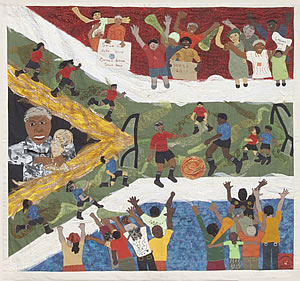 Twenty-Ten Twenty-Ten
The background of the quilt shows the flag of South Africa, and we’re proud of that. One of the players is wearing dreads, and he is Naasley Swiers, the captain of the Arts Centre’s soccer team. Ours is the red team, and the blue team is Vlak Plaas, and our team is winning. People are making a noise with the vuvuzella, to show they are happy. We are looking forward to the soccer world cup, and hope South Africa wins. We know Madiba is very proud of South Africa, so he is in the middle of the flag. Larger picture |
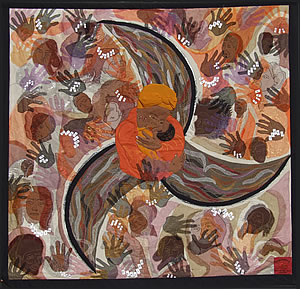 Stop Abuse Now Stop Abuse Now
The lady in the middle is one of our artists, Seraline Tromp. We call her Pumi. She is protecting her baby against abuse in our village of Nieu Bethesda. The many hands say “It’s enough now. Stop abuse now. The faces are very sad, because of all the things that they lose through this abuse, like their children are going to the welfare, or losing their childhood through being afraid all the time. We have made the hands all the colours we could find, to show that it is not happening just to one group, but to all nations worldwide. The blades are like a wheel that is cutting through the abuse. This happened after a programme we had at the Centre about abuse. After the programme we started to tackle seriously the problems of alcohol abuse in our community. It makes us sad to look at this quilt, and to talk about it. (Sold) Larger picture |
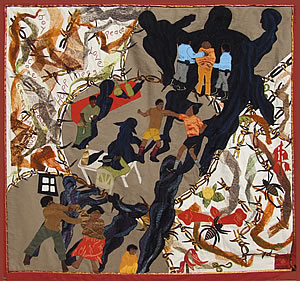 The Shadow of Abuse The Shadow of Abuse
This is what we call the long shadow of abuse, that follows a child all the way through his life. It begins at home, where he is blocking his ears because his parents are fighting and screaming at each other, and he is very frightened. The next part shows where he has grown into a teenager, and is in the tavern, drunk, and fighting with other boys. The shadow following is getting darker and bigger. In the final scene, he is being led to prison by two policemen. He has committed a crime because all the violence and anger has been stored up inside him and the shadow leads him to a life where he has no future. His life is spoilt forever. Larger picture |
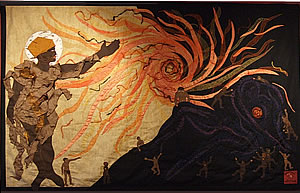 The Creation of the Sun The Creation of the Sun
This is a story we love, and have worked on twice before. Each time we work on the story, it is quite different. In this quilt, the wise old woman is huge and powerful, and the sleeping sun is almost made of darkness. But his heart has a burning centre. The Old Woman has commanded the children to throw him up into the sky, so he can shine for the whole world. Each child also has a spark of fire in his hands or heart, because children represent new life.. The creation of the sun is about the wakening of consciousness in humanity. Larger picture |
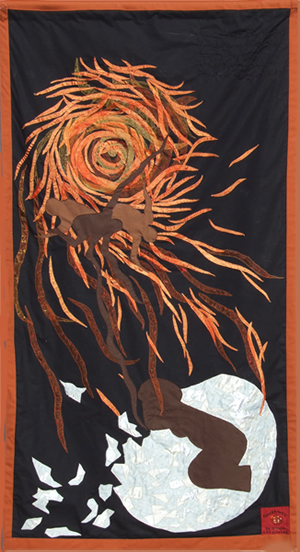 Sun Spare My Children Sun Spare My Children
“At dawn the sun fired his arrows at the moon slicing her away.
And she cried out to him, O Sun, spare my children!”
These are the words told by //Kabbo in this story, of how at sunrise, the moon is cut away by the rising sun, and cries out to him. The words are embroidered in black on black, and are hard to read, because it is hard to hear the moon as she cries out to the sun. Larger picture |
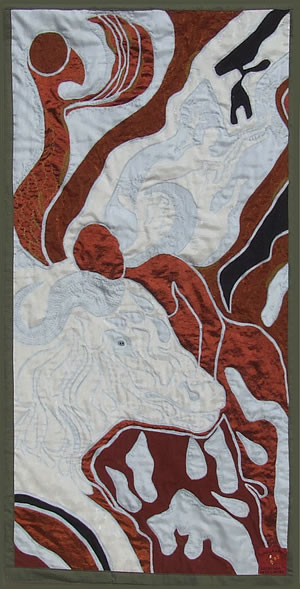 The Rainbull and the Maiden The Rainbull and the Maiden
At certain times, the young woman must remain in her hut, away from others. In this story, while she is lying on her mat, the Rainbull picks up her scent, and is attracted towards her. She too, is attracted by his scent. They meet, and she rubs buchu on his forehead to calm him. Then she mounts him in a tender yet frightening meeting and he carries her away. Later she escapes from him through the trees. If she had remained, he might have drowned her in his water pit, where she would be turned into a frog. The older women burn horns when she returns, to stop him being angry.
For us this story is about the rain fertilizing the earth. But if the storm is too strong, and the water turns into a flood, it brings danger.
Larger picture |
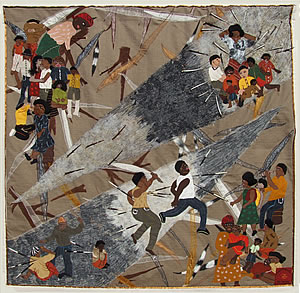 The Pain of Love The Pain of Love
This quilt is about the dual nature of love. Two huge thorns oppose each other, and on them a jealous man tries to kill his rival. In the top right hand corner a woman is in despair, because she has no food for her children, and her love for them causes her pain. On the right hand side a woman is having to leave her child to go to work, causing them both sadness.
Larger picture |
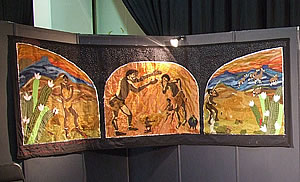 The First /Xam Man Brings Home a Young Lion The First /Xam Man Brings Home a Young Lion
In this story, the first /Xam man steals a young lion cub, and pretends to his wife that it is a dog, who will help him hunt for food. The wife knows he is lying , and warns her children. She points out that his ears are not pointy, and his eyes are yellow. As the lion grows, the man takes it hunting, but it grows bigger, and at last kills him. The wife has to leave her home with her children, because the young lion’s parents will come back and kill them all.
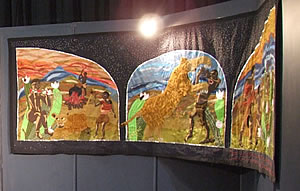 This story is relevant to many contemporary situations, and is about the abuse of power that happens everywhere. People think they can control things that are too powerful, and lie and use them for themselves. In Nieu Bethesda, the lion is like alcohol that we bring into the home, thinking we can control it, but it controls us and destroys our lives. This story is relevant to many contemporary situations, and is about the abuse of power that happens everywhere. People think they can control things that are too powerful, and lie and use them for themselves. In Nieu Bethesda, the lion is like alcohol that we bring into the home, thinking we can control it, but it controls us and destroys our lives.
Larger picture |
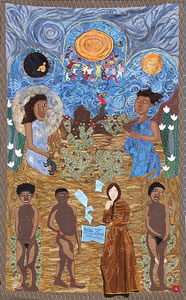 Sun and Moon Sun and Moon
This quilt is in three tiers. At the bottom is the 19th century Shaman //Kabbo, with Lucy Lloyd. Between them his stories are recorded in books, and float into the future, so that they can be preserved for future generations. In the middle tier is the story of the origin of death. The angry moon strikes the hare across its lip, because he will not stop crying for his dead mother, and curses him to die and never return. Facing them, humanity prays to the moon for life, so that we can, dying, return again. The top tier represents the creation of the Sun.
Larger picture |
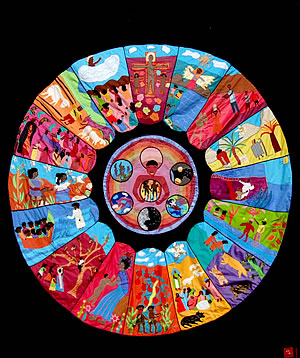 Big Story Big Story
These are the favourite bible stories of the Pomegranate artists. In the centre of the quilt, God creates the heavens and the earth. The seventh day, his day of rest, he hold inside himself. At the top of the quilt is the crucifixion. Many of the Pomegranate artists are devout Christians. At the bottom is the garden of Eden. The quilt is in the form of a rose window.
Larger picture |
© Copyright Bethesda Foundation, Bethesda Arts Centre, 2005
Registered Charity 1089122 |
| |

 Our Roots 2
Our Roots 2 The Girl Who Made Stars
The Girl Who Made Stars The Valley of Desolation
The Valley of Desolation The Birds of the Karoo
The Birds of the Karoo The Drinking Pool
The Drinking Pool Twenty-Ten
Twenty-Ten Stop Abuse Now
Stop Abuse Now The Shadow of Abuse
The Shadow of Abuse The Creation of the Sun
The Creation of the Sun Sun Spare My Children
Sun Spare My Children The Rainbull and the Maiden
The Rainbull and the Maiden The Pain of Love
The Pain of Love The First /Xam Man Brings Home a Young Lion
The First /Xam Man Brings Home a Young Lion This story is relevant to many contemporary situations, and is about the abuse of power that happens everywhere. People think they can control things that are too powerful, and lie and use them for themselves. In Nieu Bethesda, the lion is like alcohol that we bring into the home, thinking we can control it, but it controls us and destroys our lives.
This story is relevant to many contemporary situations, and is about the abuse of power that happens everywhere. People think they can control things that are too powerful, and lie and use them for themselves. In Nieu Bethesda, the lion is like alcohol that we bring into the home, thinking we can control it, but it controls us and destroys our lives.  Sun and Moon
Sun and Moon Big Story
Big Story 
